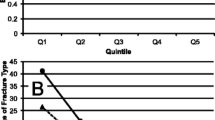Abstract
To evaluate whether metatarsal fracture in postmenopausal women can be related to osteoporosis, a sample of 113 postmenopausal women with metatarsal fracture due to minor trauma were recruited. Demographic and clinical data were compared with a control group of 339 healthy age-matched women and with a sample of 224 women with wrist fracture. In all women, bone mineral density (BMD) was measured at the lumbar spine by dual-energy X-ray absorptiometry. The average age of the metatarsal fracture group was slightly lower than that of the wrist fracture group (56.9 vs 58.4 years). Women with metatarsal and wrist fracture had a significantly higher age at menarche, lower age at menopause and lower body mass index when compared with controls. In both fracture groups BMD was significantly lower compared with controls. In stepwise logistic regression models, factors associated with metatarsal fracture risk were age at menopause (odds ratio [OR] 0.86; 95% confidence interval [CI] 0.81–0.92) and BMD (OR per — 1 SD 2.44; CI 1.92–3.11). Factors associated with wrist fracture risk included age at menopause (OR 0.89; CI 0.84–0.93) and BMD (OR per — 1 SD 2.65; CI 2.17–3.24). The similarities existing in risk factors and their estimates between a well-recognized osteoporotic fracture such as wrist fracture and metatarsal fracture, support the hypothesis that the latter can be included among osteoporotic fractures.
Similar content being viewed by others
References
Buhr AJ, Cooke AM. Fracture patterns. Lancet 1959;1:531–6.
Nguyen T, Sambrook P, Kelly P, et al. Prediction of osteoporotic fractures by postural instability and bone density. BMJ 1993;307:1111–5.
Seeley DG, Browner WS, Nevitt MC, Genant HK, Scott JC, Cummings SR. Which fractures are associated with low appendicular bone mass in elderly women? Ann Intern Med 1991;115:837–42.
Seeley DG, Browner WS, Nevitt MC, Genant HK, Cummings SR. Almost all fractures are osteoporotic [abstract]. J Bone Miner Res 1995;10(Suppl 1):S468.
Devas M. Stress fractures. In: Helal B, Wilson D, editors. The foot. London: Churchill Livingstone, 1988:967–93.
Kadel NJ, Teitz CC, Kronmal RA. Stress fractures in ballet dancers. Am J Sports Med 1992;20:445–9.
Warren MP, Brooks Gunn J, Fox RP, Lancelot C, Newman D, Hamilton WG. Lack of bone accretion and amenorrhea: evidence for a relative osteopenia in weight-bearing bones. J Clin Endocrinol Metab 1991;72:847–53.
Seeley DG, Kelsey J, Jergas M, Nevitt MC. Predictors of ankle and foot fractures in older women. J Bone Miner Res 1996;11:1347–55.
WHO Study Group. Osteoporosis. In: Technical report series 843. Assessment of fracture risk and its application to screening for postmenopausal osteoporosis. Geneva: WHO, 1994:2–25.
Rupani HD, Holder LE, Espinola DA, Engin SI. Three-phase radionuclide bone imaging in sports medicine. Radiology 1985;156:187–96.
Riggs BL, Hodgson SF, O’Fallon WM, et al. Effect of fluoride treatment on the fracture rate in postmenopausal women with osteoporosis. N Engl J Med 1990;322:802–9.
Guanabens N, Peris P, Monegal A, Pons F, Collado A, Munoz-Gomez J. Lower extremity stress fractures during intermittent cyclical etidronate treatment for osteoporosis. Calcif Tissue Int 1994;54:431–4.
Giladi M, Milgrom C, Simkin A, Danon Y. Stress fractures: identifiable risk factors. Am J Sports Med 1991;19:647–52.
Melton LJ III, Riggs BL. Epidemiology of age-related fractures. In: Avioli LD, editor. The osteoporotic syndrome: detection, prevention and treatment. New York: Grune and Stratton, 1983:45–72.
Black DM, Cummings SR, Genant HK, Nevitt MC, Palermo L, Browner WS. Axial and appendicular bone density predict fractures in older women. J Bone Miner Res 1992;7:633–8.
Melton LJ III, Atkinson EJ, O’Fallon WM, Wahner HW, Riggs BL. Long-term fracture prediction by bone mineral assessed at different skeletal sites. J Bone Miner Res 1993;8:1127–33.
Owen RA. Melton LJ III, Johnson KA, Ilstrup DM, Riggs BL. Incidence of Colles’ fracture in a North American community. Am J Public Health 1982;72:605–7.
Nilson BER. Age and sex incidence of ankle fractures. Acta Orthop Scand 1969;40:122–9.
Parfitt AM. Age-related structural changes in trabecular and cortical bone: cellular mechanisms and biomechanical consequences. Calcif Tissue Int 1984;36:S123–8.
Arnold JS, Bartley MH, Tont SA, Jenkins DP. Skeletal changes in aging and disease. Clin Orthop Rel Res 1966;49:17–38.
Parfitt AM. Richmond Smith as a clinical investigator: his work on adult periosteal bone expansion, and on nutritional and endocrine aspects of osteoporosis, in the light of current concepts. HFH Med J 1980;28:95–107.
Nordin BEC, Need AG, Chatterton BE, Horowitz M, Morris HA. The relative contributions of age and years since menopause to postmenopausal bone loss. J Clin Endocrinol Metab 1990;70:83–8.
Kritz-Silverstein D, Barret-Connor E. Early menopause, number of reproductive years, and bone mineral density in postmenopausal women. Am J Public Health 1993;83:983–8.
Katz JL, Yoon HS, Lipson S, Maharidge R, Meunier A, Christel P. The effects of remodeling on the elastic properties of bone. Calcif Tissue Int 1984;36:S31–6.
Frost HM. The role of changes in mechanical usage set points in the pathogenesis of osteoporosis. J Bone Miner Res 1992;7:253–61.
Pentecost RL, Murray RA, Brindley HH. Fatigue, insufficiency, and pathologic fractures. JAMA 1964;187:1001–4.
Author information
Authors and Affiliations
Rights and permissions
About this article
Cite this article
Varenna, M., Binelli, L., Zucchi, F. et al. Is the metatarsal fracture in postmenopausal women an osteoporotic fracture? A cross-sectional study on 113 cases. Osteoporosis Int 7, 558–563 (1997). https://doi.org/10.1007/BF02652562
Received:
Accepted:
Issue Date:
DOI: https://doi.org/10.1007/BF02652562




